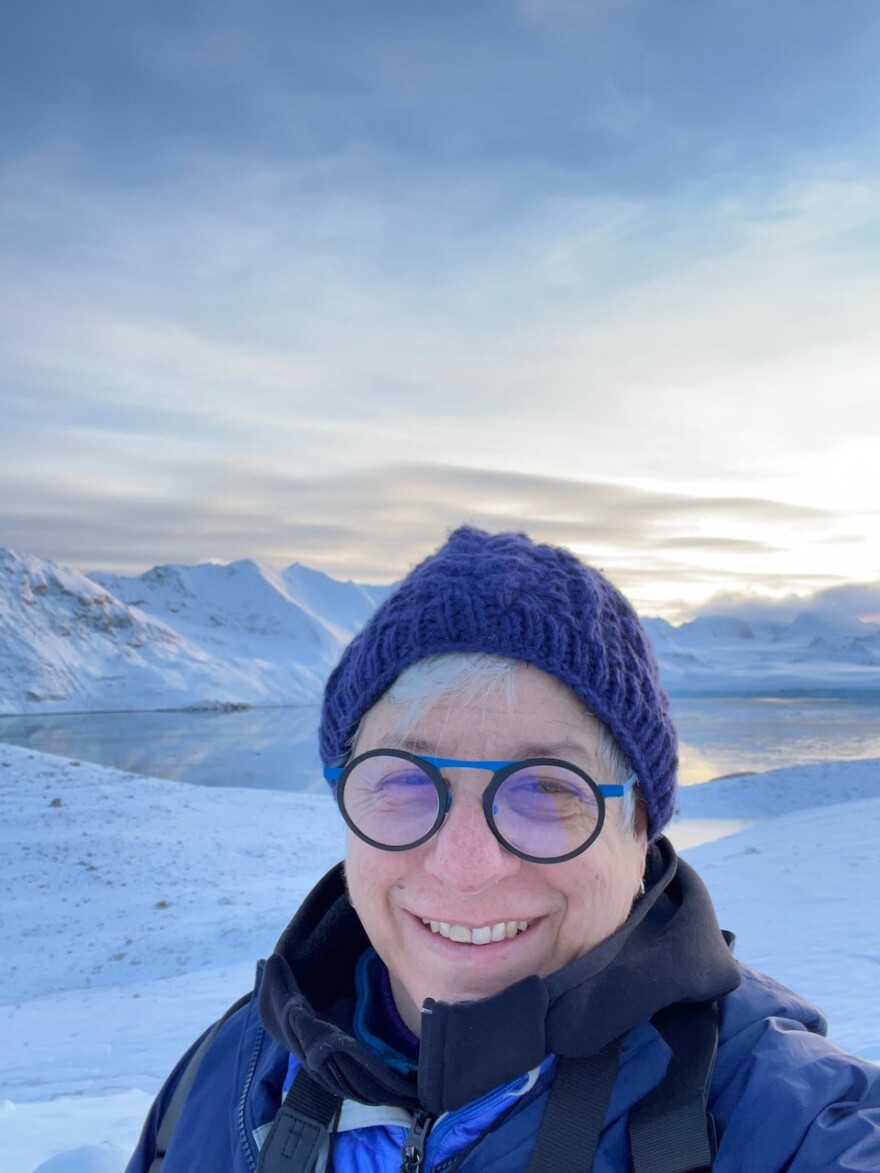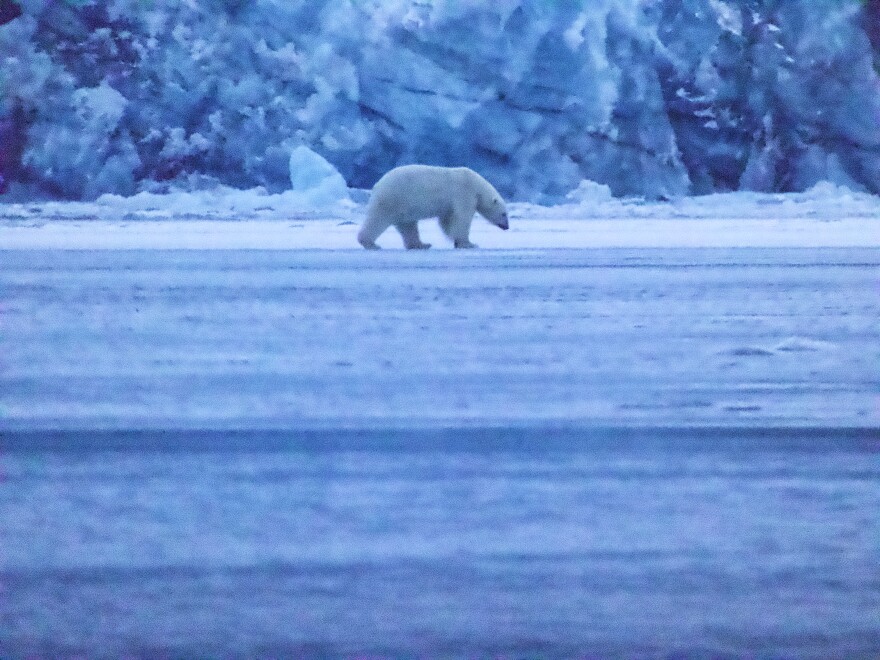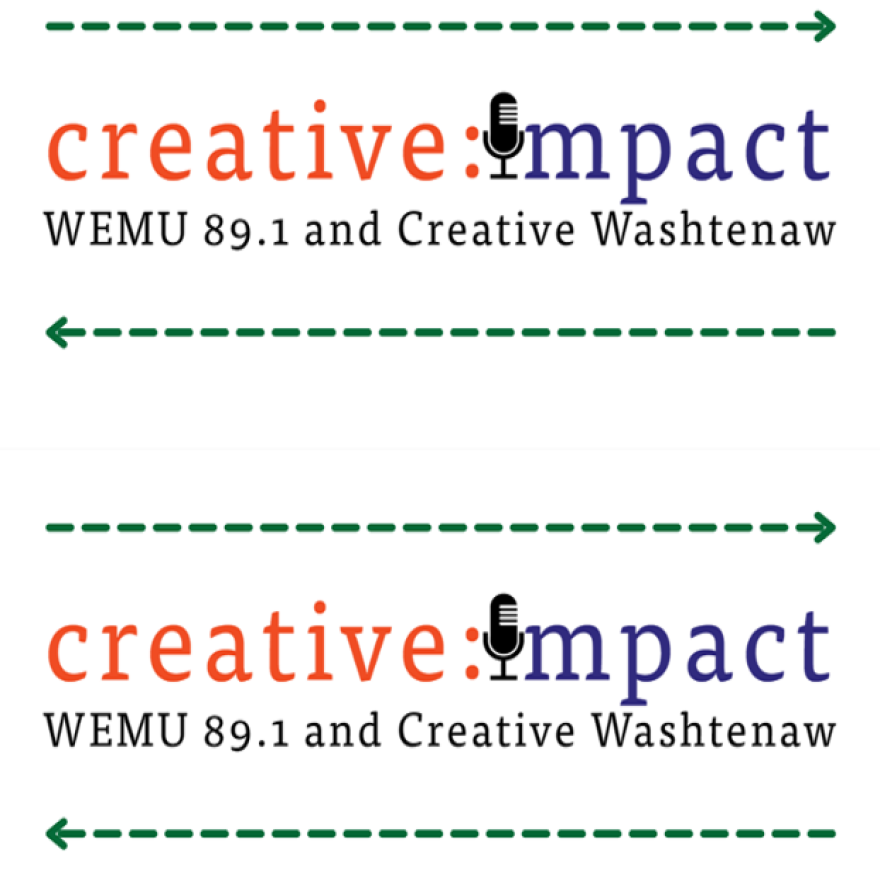Creative industries in Washtenaw County add hundreds of millions of dollars to the local economy. In the weeks and months to come, host Deb Polich, the President and CEO of Creative Washtenaw, explores the myriad of contributors that make up the creative sector in Washtenaw County.

ABOUT LESLIE SOBEL:

Leslie Sobel is the artist daughter of two scientists. The dual perspective of art and science drives her work. Her work reflects her her deep focus on climate change and our disconnect from the natural world. She works integrating wilderness fieldwork in remote places with scientists and time in the studio. In 2017, she camped on an ice field in Yukon Territory with a group of glaciologists and she continues to collaborate with those and other climate scientists focusing on the effects of climate change on the high latitudes. Her BFA is from the University of Michigan, MFA from the University of Hartford. She works in mixed media frequently incorporating photography, scientific data and more traditional materials.
She has shown widely with numerous solo exhibitions and has curated a number as well. She worked in tech for a decade and did masters work in technology management. Her experiences as an activist, a mother of three adult children, a caregiver for a 90+ father, and former tech entrepreneur reflect the way many women are pulled in multiple directions - both strengthening and challenging her focus as an artist.
ABOUT THE ARCTIC CIRCLE:
Artist and scientist led, The Arctic Circle is an annual expeditionary residency program.
Established in 2009, The Arctic Circle brings together international artists of all disciplines, scientists, architects, and educators who collectively explore the high-Arctic Svalbard Archipelago and Arctic Ocean aboard a specially outfitted Barquentine sailing vessel.
The Arctic Circle provides a shared experience for its participants to engage in the myriad issues relevant to our time and to develop professionally through fieldwork and research, interdisciplinary collaborations, exhibit opportunities, and public and classroom engagement.
The Arctic Circle program supports the creation and exhibition of new and pioneering work, and aims to empower the creative individual while fostering the collaborative.
Please join The Arctic Circle mailing list, by emailing us at news@thearcticcircle.org, to stay current with program updates and to receive calls for applications for our annual expeditions.
RESOURCES:
Past participants of The Arctic Circle
TRANSCRIPTION:
Deb Polich: Welcome to creative:impact on 89 one WEMU. I'm Deb Polich, president and CEO of Creative Washtenaw and your creative:impact host. Thanks for tuning in to meet creative guests deeply rooted in Washtenaw County and discovering how their legacy makes Washtenaw County one of the most artistically vibrant regions in Michigan and the nation. I'm very pleased to welcome back Leslie Sobel to the studio for the second segment of a two-part series on artist residencies. Last week, Leslie answered my questions about the structure of artist residencies and how her experiences have informed her practice as an artist whose work is deeply focused on climate change and our disconnect from the natural world. For any of you that missed part one, you can find it at WEMU dot org. And today, we are going to live vicariously through Leslie as she takes us on her latest residency and an amazing voyage to the Arctic Circle. Leslie, welcome back.
Leslie Sobel: Thanks for having me, Deb.
Deb Polich: Yeah. So, I can't really wait to get started. But, if I recall, you had to wait quite a while to get this residency started because of the ubiquitous interruption of COVID.
Leslie Sobel: I did.
Deb Polich: How long were you delayed?
Leslie Sobel: Two years.
Deb Polich: Two years?
Leslie Sobel: Yep.
Deb Polich: Did you ever wonder if it was really going to happen?
Leslie Sobel: When we got to the ship, we all looked at each other and kind of pinched each other. We couldn't believe it was finally happening.
Deb Polich: I bet. So, tell us about the Arctic Circle Residency, its mission, and its participants.
Leslie Sobel: So, this is a residency that is based on a tall ship, the sailing barquentine Antigua.
Deb Polich: Like one of those really beautiful old wood ships?
Leslie Sobel: Yeah. A three-masted barquentine. And, yes, we did do some actual sailing--although, to be fair, more time motoring than not.
Deb Polich: Okay.
Leslie Sobel: But there were 29 artists and four guards because you need guards with rifles any time you get off the ship because of polar bears.

Deb Polich: Oh, okay.
Leslie Sobel: And a crew of seven.
Deb Polich: Okay. So, they were all artists.
Leslie Sobel: The 29 residents were artists. As it turns out, the guards were mostly artists as well.
Deb Polich: Oh, really?
Leslie Sobel: Yeah.
Deb Polich: That's pretty cool. And from all over the world, I'm imagining.
Leslie Sobel: Yeah, we had a group from..not a group, but there were three people from Hong Kong who did not know each other previously.
Deb Polich: Okay.
Leslie Sobel: A few Canadians. Somebody from Germany. Norway. Where else? A few other countries.
Deb Polich: And you mentioned a ship. So, where did you disembark from, and how did you get there?
Leslie Sobel: Well, the residency starts in the northernmost community in the world, which is Longyearbyen in Svalbard. And it's a town of 2,500 people.
Deb Polich: And I'm sorry. Which country?
Leslie Sobel: Svalbard is sort of part of Norway, but not really.
Deb Polich: Oh, its own governance.
Leslie Sobel: Yeah. It's an archipelago north of Norway.
Deb Polich: Okay.
Leslie Sobel: And it's a weird. I mean, actually, you leave the Schengen to go there. You have to go through customs. It's kind of weird.
Deb Polich: I should have brought a globe with me, so I could have looked at all that. But, anyway, what did you feel upon your arrival, and what were your first impressions?
Leslie Sobel: I was giddy.
Deb Polich: Yeah.
Leslie Sobel: I was so excited to be there. And Longyearbyen is a town on Isjordan Ice Fjord, which is the biggest fjord in all of Svalbard. And it's a community that started out as a place that was based in mining and whaling and other extraction. And Norway has really shifted it to being about tourism and science.
Deb Polich: Okay.
Leslie Sobel: So, there's a university there. There's a lot of research there. It's in a valley between big mountains. And all around the perimeter of the town are signs about where it's safe for polar bears. You can go here. You can't go there unless you have an armed guard.
Deb Polich: Okay. And what were the temperatures?
Leslie Sobel: Oh, we started around freezing and went down to about the coldest was about -10 C, which is what, 16, 14 Fahrenheit?
Deb Polich: That's pretty cold.
Leslie Sobel: Yeah, it's pretty cold.
Deb Polich: Yeah, yeah, yeah. So, how was this residency structured? Did you and the participants basically have free rein, or did you just have to discover things on your own, or was it structured?
Leslie Sobel: It was pretty structured because it had to be, because of the aforementioned polar bears and logistics.
Deb Polich: Okay.
Leslie Sobel: So, what happened at the very beginning was that everybody sat down with Sarah, our exhibition leader--Expedition. Excuse me--leader and Sergei, her logistics guy. And we would talk about our projects.
Deb Polich: Okay.
Leslie Sobel: So, she knew what everybody's needs were. And then, they structured where we went and what our activities were based on those needs. For example, there were a bunch of sound artists who had hydrophones who needed time to do underwater recording. There was one artist who was dragging canvas around to pick up whatever local pigments that were on her canvases. I'm interested in glacial retreat, so I wanted to go places where the glaciers were retreating and be able to document it. That turns out to be absolutely everywhere.
Deb Polich: And we'll get back to that in just a second. But 89 one WEMU's creative:impact continues. I'm Deb Polich, and my guest is visual artist Leslie Sobel, who is regaling us with tales of her recent Arctic Circle residency. So, what did you see that helped you understand your interest in what you wanted to document and create?
Leslie Sobel: So, we got on the ship and sailed overnight south to Hornsunde. And I have given you a map that you can include on the website.
Deb Polich: So, thank you very much for that.

Leslie Sobel: When viewers look at that map and see it's the southernmost inlet .and that inlet is going to be a channel completely through within very few years because it turns out it's just glacier. It's not land. And so, then the bottom tip of--
Deb Polich: It's all eroding. It's all melting.
Leslie Sobel: It's all melting. Yeah. And that used to be the whole Bay Area, which is really large. It was one glacier. And, at this point, there are eight separate glacier faces because it's melted so far.
Deb Polich: So, you mentioned that this area is now a place for artists and scientists. Did you get to interact with the scientists? And is that informing what you absorbed?
Leslie Sobel: I did a little. I got exposed to some scientists work that deeply interests me. And we've exchanged emails, and I'm hoping that I'll get back there to work with them or be able to work remotely. We'll see.
Deb Polich: And did you and the other artists start creating there on site, or are you coming home to create work inspired by your experiences?
Leslie Sobel: It's a mix. I did very little plein air drawing because it's just too darn cold in those circumstances.
Deb Polich: Right.
Leslie Sobel: But we did have a heated workroom on the deck, so I did a lot of sketchbook work there. I took literally thousands of photos, and I kept a journal. So, I have a lot of raw material.
Deb Polich: And we'll see a lot of those, not all of thousand, but many of them on site. So, did you reside in the ship?
Leslie Sobel: Mm hmm.
Deb Polich: Oh. So, you didn't actually have like a place to go on land?
Leslie Sobel: We got off the ship every day in little zodiac boats to go hike and explore and draw and listen and sometimes just ride around in the zodiacs. But everybody slept in cabins in the ship.
Deb Polich: And with this residency, does your work then become part of either digitally or really part of the collection of the residency--the Arctic residency--or do you retain all of it?
Leslie Sobel: I retain all of it. But they do have a website, the Arctic Circle dot org, where you can see lists of all the past participants. And I think there are more than 300 of us at this point. And it links to everybody's websites.
Deb Polich: So, since getting back, have you gotten into the studio, or is it all still--she's laughing at me.
Leslie Sobel: Well...
Deb Polich: And you just got back when?
Leslie Sobel: Yeah, I got back on the third.
Deb Polich: Okay.
Leslie Sobel: And promptly came down with COVID. No surprise after four flights.
Deb Polich: So, no. You haven't been back in the studio.
Leslie Sobel: No. I'm packing the studio to move. So, if I get back to work by January, I'll be very happy. But it's a lot of digesting time.
Deb Polich: I was going to say. It's a lot percolating as to what you want to express. And what do you think we're going to get as your viewers eventually? Are we going to understand climate change a little better?
Leslie Sobel: I hope so. The far north and south are the places that are melting the fastest.
Deb Polich: Okay.

Leslie Sobel: And so, they're really disproportionately important. And it's very visible when you're there, if you know what to look for and if you have an informed person telling you the glacier was here six years ago. And now, it's retreated this many kilometers.
Deb Polich: Okay. Of course, they're tracking it in that way. Well, I know I can't wait to see what you create, and we'll look forward to whatever it is next spring, I hope. And I'm sure that our listeners will be interested as well. Thank you for giving us just this little bit of insight. I can only imagine what this experience has been like, but thanks for sharing.
Leslie Sobel: Oh, it was a great pleasure, Deb.
Deb Polich: Yeah, thanks. That's Leslie Sobel. And we've been talking about the Arctic Circle residency that she has been on for--how long were you there?
Leslie Sobel: Well, the whole trip was about a month, but we were on the ship for a couple of weeks.
Deb Polich: Okay. So, a month. And you can find out more about Leslie and her journey at WEMU dot org. And there is going to be some really amazing images. So, we're looking forward to that. And you've been listening to creative:impact. I'm Deb Polich, president and CEO of Creative Washtenaw and your host. Mat Hopson is our producer. And we invite you to join us every Tuesday to meet creative Washtenaw guests. Celebrating 45 years of jazz broadcasting, this is 89 one WEMU Ypsilanti. Public radio from Eastern Michigan University.

Non-commercial, fact based reporting is made possible by your financial support. Make your donation to WEMU today to keep your community NPR station thriving.
Like 89.1 WEMU on Facebook and follow us on Twitter
Contact WEMU News at 734.487.3363 or email us at studio@wemu.org







